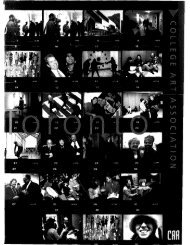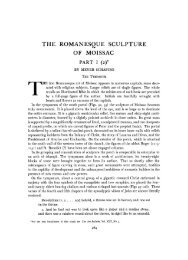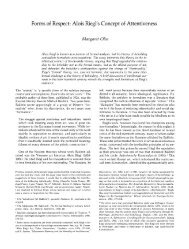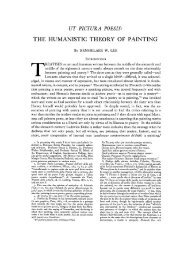Tragic Pompeii - College Art Association
Tragic Pompeii - College Art Association
Tragic Pompeii - College Art Association
Create successful ePaper yourself
Turn your PDF publications into a flip-book with our unique Google optimized e-Paper software.
246 THE ART BULLETIN JUNE 1994 VOLUME LXXVI NUMBER 2<br />
identical peacock stands below each panel as if in mirror<br />
image. Subtly, the subordinate designs of the framework<br />
interlace with the serial figural compositions.<br />
If the scenes successfully simulate independent panels, a<br />
look at the room as a whole reveals unmistakably that they<br />
were also composed for this space. Yet this fact need not<br />
minimize their meaning. For the recurring patterns function<br />
somewhat like a metrical scheme that relates the distinct<br />
stories to a familiar refrain.41 That refrain poses a few large,<br />
binary themes: love and war, passion and reason, gods and<br />
mortals, all played out in overlapping and interlocking<br />
groups (Fig. 28). Three panels feature Olympians in their<br />
distinctive and contrasting roles-Zeus and Hera, Aphrodite,<br />
Poseidon and Amphitrite, while Athena plays a role in a<br />
fourth. The three other panels conjure up the beginnings of<br />
the Trojan War: the Flight of Helen caused the war, and the<br />
Removal of Briseis incited Achilles' wrath, which led to his<br />
fight with Agamemnon and to mounting trouble for the<br />
Greeks.<br />
Within this hierarchy of mortals and immortals, men and<br />
women relate in a variety of ways. Featured are the archetypal<br />
marriage of Zeus and Hera, the master-slave relationship<br />
of Achilles and Briseis, the adulterous union of Helen<br />
and Paris, and the abduction/wedding of Amphitrite by<br />
Poseidon. Indeed, sexual bonds resonate through the disparate<br />
scenes, and Aphrodite was operative in many of these<br />
relationships.42 To the two goddesses flanking her, she had<br />
presented wedding gifts: to Hera the prominent veil, to<br />
Amphitrite a purple cloak and a gold crown; to Paris she had<br />
given Helen. The oblique connection between Aphrodite<br />
and Helen across the atrium space (Fig. 23 b and e)<br />
intersected with others, such as the two marriages of the<br />
brother gods Zeus and Poseidon (Fig. 23 a and d) and the<br />
two abductions of Amphitrite and of Helen (Fig. 23 d and e).<br />
The visitor to the House of the <strong>Tragic</strong> Poet could have<br />
perceived myriad combinations in walking through this<br />
space-pairs, triplets, and diagonal cross-references from<br />
wall to wall-depending upon the chosen route. As in the<br />
architectural mnemonic, recollection was achieved through<br />
the association of the image with the idea. The Roman figure<br />
in our model demonstrates how only two or three scenes fell<br />
within the arc of vision at one time and how with a rotation or<br />
advance in space the connections would change and multiply<br />
(Fig. 29). But despite their apparent looseness, the formal<br />
and thematic arrangements of panels, and even of whole<br />
walls, corresponded to the well-known rhetorical principles<br />
4' On Homer's metrical scheme, the formulaic type scenes of oral<br />
transmission, and structural correspondences linking scene to scene, see<br />
B. Knox, "Introduction," in The Iliad, trans. Fagles, 3-22.<br />
42 Schefold (as in n. 22), 209-217, actually interprets the atrium series as<br />
a Venerean program.<br />
43 Aristotle, De memorza 451b.18-20, trans. G. R. T. Ross, Cambridge,<br />
1906, 109-111: in recollecting "we hunt for the next in the series,<br />
starting our train of thought from what is now present ... or from<br />
something similar or contrary or continguous to it." On these principles<br />
of order and association in visual narrative: Brilliant (as in n. 5), 71; in<br />
memory: Yates, 34. On the same principles in domestic sculptural<br />
programs, with literary parallels from Ovid and Propertius, see R.<br />
Neudecker, Die Skulpturenausstattung romzscher Vzllen zn Italzen, Mainz,<br />
of similtudo, vzcznitas, and contrarium, whereby things that are<br />
similar, near, or antithetical, provoke certain trains of<br />
thought. These simple and effective principles had been<br />
prescribed centuries earlier by Aristotle for memory, and<br />
they were prominent in the use of mythical tales by contemporary<br />
Latin writers.43<br />
Perhaps most suggestive of the way the open-ended<br />
ordering of the stories "worked" is the triangular relation-<br />
ship evident among the panels depicting the Return of<br />
Briseis, the Abduction of Helen, and the Wrath of Achilles,<br />
(Fig. 23 c, e, f). In the Iliad, the violent encounter between<br />
Achilles and Agamemnon was the direct aftermath of the<br />
taking of Briseis, and the two scenes were combined in<br />
Aeschylus's Achilles trilogy, the Nereides. Although these<br />
serial episodes were placed diagonally across the atrium,<br />
visual devices such as the purple robes of the two seated<br />
leaders and the shields that are placed, like haloes, behind<br />
their heads, establish correspondences that underline the<br />
cause and effect of Achilles' anger (Figs. 16, 27, right).<br />
Compositionally, the Wrath of Achilles panel also mirrored<br />
that of Helen directly across (Figs. 17, 27, right), for if Paris<br />
indeed sat on the boat to the right of Helen, his position<br />
would parallel that of Agamemnon, and the discerning<br />
viewer could foresee Achilles' death at the hands of Paris, the<br />
Trojan prince, and perhaps even recognize a connection<br />
between Paris and Agamemnon: both had taken women<br />
from other men (Paris, Helen from Menelaos and Agamemnon,<br />
Briseis from Achilles) and Achilles himself makes an<br />
analogy between the two thefts. Helen and Achilles, both<br />
charismatic figures who stand apart from the rest in the saga<br />
of Troy, move back toward the entrance of the atrium,<br />
visually closing the series (Fig. 28). Yet Helen's step signifies<br />
the desire that will lead her on, while Achilles' passion is held<br />
back. Through these mortal agents, the goddesses Aphrodite<br />
and Athena pursue their different ends.44 This triad, then,<br />
connects the two major turning points in the Trojan War: the<br />
original impetus to fight and the cause of anger between the<br />
Greeks and Trojans, the capture of Helen, and the temporary<br />
rupture among the Greeks, caused by Achilles' anger at<br />
the capture of Briseis.<br />
Memory Theater<br />
Thus reconstituted, the atrium, a traditional Roman space,<br />
emerges as a storehouse filled with stories of Greek gods and<br />
Bronze Age heroes. Here memoria became a means of<br />
appropriation, for the Roman architectural frame and the<br />
1988, 39-47. For the use of juxtapositions of similar and contrasting<br />
subjects in a didactic state frieze: E. D'Ambra, Przvate Lzves, Imperzal<br />
Vzrtues: The Frzeze of the Forum Transztorzum zn Rome, Princeton, 1991,<br />
chap. 2. On the cultivation of Greek mythological exempla in Roman<br />
society: H. Jucker, Vom Verhaltnzs der Romer zur bildenden Kunst der<br />
Griechen, Frankfurt, 1950, chap. 2; G. Williams, Change and Declzne:<br />
Roman Literature in the Early Roman Empire, Berkeley, 1978, chap. 3. On<br />
literary taste in <strong>Pompeii</strong>: M. Gigante, Czvzltd delleforme letterarze nell'antzca<br />
Pompez, Naples, 1979.<br />
44<br />
Ilzad 22.359-360; 9.337-345, trans. Fagles, 553; 262-263. Knox (as<br />
in n. 41), 45-46, links Achilles and Helen as especially powerful, godlike<br />
mortals.










